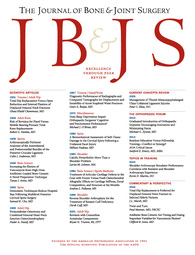
TRAUMA
Pulsatile vs standard compression: no significant difference against deep vein thrombosis
J Bone Joint Surg Am. 2001 Jul;83-A(7):1047-51107 patients with pelvic or acetabular fractures requiring internal fixation were randomized to receive prophylaxis against deep vein thrombosis with either a thigh-calf low-pressure sequential-compression device (Group A) or a calf-foot high-pressure pulsatile-compression pump (Group B). Patients were assessed for the development of deep vein thrombosis (by duplex ultrasonography and magnetic resonance venography), which trended toward lower prevalence in Group B, but did not reach significance. Higher rates of thrombosis were associated with increasing patient age and the time between injury and surgery.
Unlock the full ACE Report
You have access to {0} free articles per month.Click below to unlock and view this {1}
Unlock NowCritical appraisals of the latest, high-impact randomized controlled trials and systematic reviews in orthopaedics
Access to OrthoEvidence podcast content, including collaborations with the Journal of Bone and Joint Surgery, interviews with internationally recognized surgeons, and roundtable discussions on orthopaedic news and topics
Subscription to The Pulse, a twice-weekly evidence-based newsletter designed to help you make better clinical decisions
Exclusive access to original content articles, including in-house systematic reviews, and articles on health research methods and hot orthopaedic topics
Or upgrade today and gain access to all OrthoEvidence content for just $1.99 per week.
Already have an account? Log in


Subscribe to "The Pulse"
Evidence-Based Orthopaedics direct to your inbox.
{0} of {1} free articles
Become an OrthoEvidence Premium Member. Expand your perspective with high-quality evidence.
Upgrade Now












































































